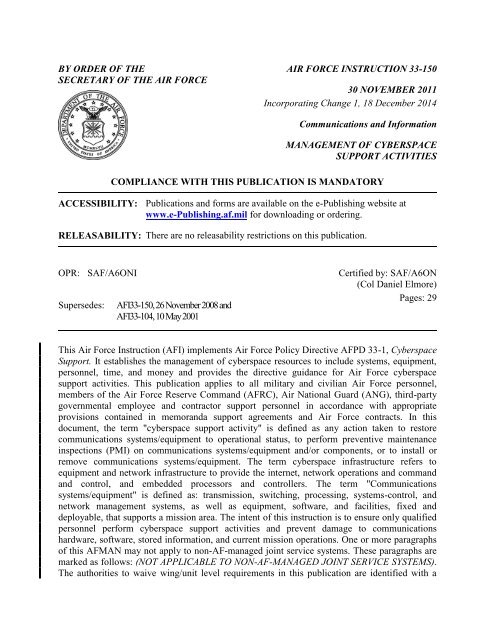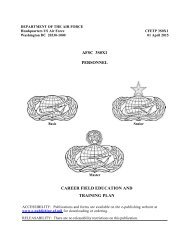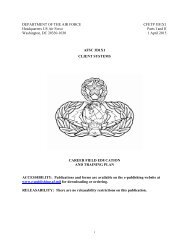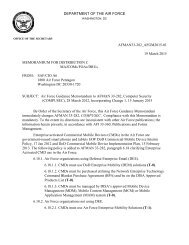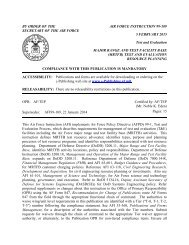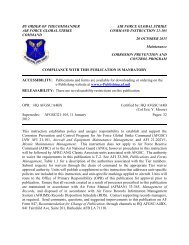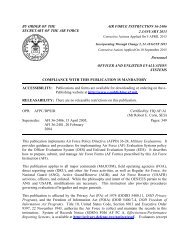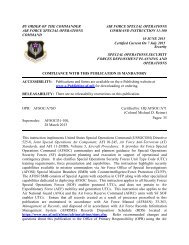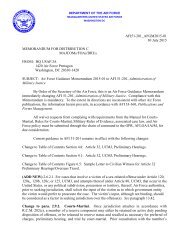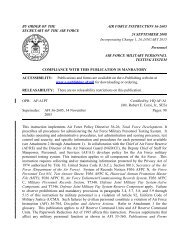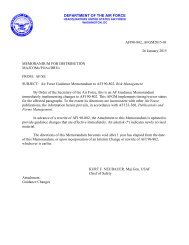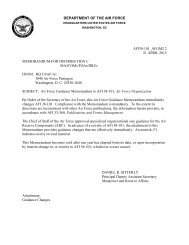SAF/CIO - Air Force Link
SAF/CIO - Air Force Link
SAF/CIO - Air Force Link
Create successful ePaper yourself
Turn your PDF publications into a flip-book with our unique Google optimized e-Paper software.
BY ORDER OF THE<br />
SECRETARY OF THE AIR FORCE<br />
AIR FORCE INSTRUCTION 33-150<br />
30 NOVEMBER 2011<br />
Incorporating Change 1, 18 December 2014<br />
Communications and Information<br />
MANAGEMENT OF CYBERSPACE<br />
SUPPORT ACTIVITIES<br />
COMPLIANCE WITH THIS PUBLICATION IS MANDATORY<br />
ACCESSIBILITY: Publications and forms are available on the e-Publishing website at<br />
www.e-Publishing.af.mil for downloading or ordering.<br />
RELEASABILITY: There are no releasability restrictions on this publication.<br />
OPR: <strong>SAF</strong>/A6ONI<br />
Supersedes:<br />
AFI33-150, 26 November 2008 and<br />
AFI33-104, 10 May 2001<br />
Certified by: <strong>SAF</strong>/A6ON<br />
(Col Daniel Elmore)<br />
Pages: 29<br />
This <strong>Air</strong> <strong>Force</strong> Instruction (AFI) implements <strong>Air</strong> <strong>Force</strong> Policy Directive AFPD 33-1, Cyberspace<br />
Support. It establishes the management of cyberspace resources to include systems, equipment,<br />
personnel, time, and money and provides the directive guidance for <strong>Air</strong> <strong>Force</strong> cyberspace<br />
support activities. This publication applies to all military and civilian <strong>Air</strong> <strong>Force</strong> personnel,<br />
members of the <strong>Air</strong> <strong>Force</strong> Reserve Command (AFRC), <strong>Air</strong> National Guard (ANG), third-party<br />
governmental employee and contractor support personnel in accordance with appropriate<br />
provisions contained in memoranda support agreements and <strong>Air</strong> <strong>Force</strong> contracts. In this<br />
document, the term "cyberspace support activity" is defined as any action taken to restore<br />
communications systems/equipment to operational status, to perform preventive maintenance<br />
inspections (PMI) on communications systems/equipment and/or components, or to install or<br />
remove communications systems/equipment. The term cyberspace infrastructure refers to<br />
equipment and network infrastructure to provide the internet, network operations and command<br />
and control, and embedded processors and controllers. The term "Communications<br />
systems/equipment" is defined as: transmission, switching, processing, systems-control, and<br />
network management systems, as well as equipment, software, and facilities, fixed and<br />
deployable, that supports a mission area. The intent of this instruction is to ensure only qualified<br />
personnel perform cyberspace support activities and prevent damage to communications<br />
hardware, software, stored information, and current mission operations. One or more paragraphs<br />
of this AFMAN may not apply to non-AF-managed joint service systems. These paragraphs are<br />
marked as follows: (NOT APPLICABLE TO NON-AF-MANAGED JOINT SERVICE SYSTEMS).<br />
The authorities to waive wing/unit level requirements in this publication are identified with a
2 AFI33-150 30 NOVEMBER 2011<br />
Tier (“T-0, T-1, T-2, T-3”) number following the compliance statement. See AFI 33-360,<br />
Publications and Forms Management, Table 1.1 for a description of the authorities associated<br />
with the Tier numbers. Submit requests for waivers through the chain of command to the<br />
appropriate Tier waiver approval authority, or alternately, to the Publication OPR for non-tiered<br />
compliance items. Send recommended changes or comments using AF Form 847,<br />
Recommendation for Change of Publication, to Cyberspace Strategy and Policy Division<br />
(<strong>SAF</strong>/A6SS), 1030 <strong>Air</strong> <strong>Force</strong> Pentagon, Washington DC 20330-1030. When collecting and<br />
maintaining information protect it by the Privacy Act of 1974 authorized by 10 U.S.C. 8013.<br />
Ensure that all records created as a result of processes prescribed in this publication are<br />
maintained in accordance with <strong>Air</strong> <strong>Force</strong> Manual (AFMAN) 33-363, Management of Records<br />
and disposed of in accordance with <strong>Air</strong> <strong>Force</strong> Records Disposition Schedule (RDS) located in the<br />
<strong>Air</strong> <strong>Force</strong> Records Information Management System (AFRIMS). See Attachment 1 for a<br />
glossary of references and supporting information.<br />
SUMMARY OF CHANGES<br />
This interim change (1) incorporates responsibilities of Installation Communication Squadron<br />
(CS) Commanders and Tenant Unit Commanders previously documented in AFI 33-101,<br />
Commanders Guidance and Responsibilities (rescinded); (2) adds AF Data Center Consolidation<br />
responsibilities and guidance previously identified via AF Guidance Memorandum; (3) updates<br />
office symbol and responsibilities for 38th Cyberspace Engineering Installation Group (38<br />
CEIG); (4) adds requires for AFTO Form 747, Cyberspace Infrastructure Systems Acceptance,<br />
and AFTO Form 229, Engineering Installation Assistance; (5) adds Tier waiver approval<br />
authorities according to AFI 33-360; (6) removes ATCALS references based on transfer to<br />
AF/A3. A margin bar ( | ) indicates newly revised material.<br />
1. Purpose. .................................................................................................................. 2<br />
2. Roles and Responsibilities. .................................................................................... 3<br />
3. Data Servers And Data Centers Approval Process. ............................................... 14<br />
Attachment 1—GLOSSARY OF REFERENCES AND SUPPORTING INFORMATION 19<br />
1. Purpose. This instruction implements new communications systems/equipment activity<br />
guidelines and changes or eliminates the requirement to complete redundant procedures and<br />
practices. Guidance in this publication is intended to assist <strong>Air</strong> <strong>Force</strong> personnel in identifying<br />
activities required to support <strong>Air</strong> <strong>Force</strong> communications. This instruction is an initiative to<br />
reduce the number of <strong>SAF</strong>/<strong>CIO</strong> A6 departmental- level publications by changing their<br />
publications from "stove-piped" system/program-based to audience/role-based focus. Specific<br />
procedural information is located in the more detailed Methods and Procedures Technical Orders<br />
(MPTO) or specialized publications. Common core communication services for standard user<br />
information (e.g., e-mail, phone, messaging, etc.) are located in AFMAN 33-152, Users<br />
Responsibilities and Guidance for Information Systems. Guidance for acquisition and<br />
sustainment planning is located in AFI 63-101, Integrated Life Cycle Management.
AFI33-150 30 NOVEMBER 2011 3<br />
1.1. Objectives. The primary objectives of cyberspace support activities are to ensure<br />
continuous security, operational availability, and reliability of systems and equipment<br />
supporting the <strong>Air</strong> <strong>Force</strong> mission. This instruction outlines unit roles and responsibilities to<br />
ensure communications systems/equipment are serviceable and properly configured to meet<br />
mission requirements.<br />
1.2. Intent. This instruction mandates the use of MPTO 00-33A-1001, General Cyberspace<br />
Support Activities Management Procedures and Practice Requirements, which establishes<br />
implementation guidance and procedures; MPTO 00-33D-3003, Managing the Cyberspace<br />
Infrastructure with the Cyberspace Infrastructure Planning System, which explains how to<br />
use the Cyberspace Infrastructure Planning System (CIPS) to document, fund, distribute,<br />
implement, and manage the cyberspace infrastructure; and MPTO 33D-2002, Engineering,<br />
Implementation, and Cyberspace Readiness Activities Management, which defines the<br />
processes and procedures for the management of Engineering Installation (EI) and<br />
Cyberspace Readiness activities to include providing Major Commands (MAJCOMs) and<br />
bases with the necessary information to process EI requirements for funding via the <strong>Air</strong><br />
<strong>Force</strong> (AF) EI Work Plan in CIPS. These elements support the objectives in paragraph 1.1.<br />
Note: This AFI and supporting MPTOs cannot alter or supersede the existing authorities and<br />
policies of the Director of National Intelligence (DNI) regarding the protection of Sensitive<br />
Compartmented Information (SCI) systems or intelligence, surveillance, reconnaissance<br />
mission and mission support systems. This AFI and supporting MPTOs cannot alter or<br />
supersede higher authoritative guidance governing Special Access Program (SAP) systems,<br />
counterintelligence or law enforcement collection operations, or investigations involving<br />
communication systems. When DNI or SAP authorities fail to address areas covered by this<br />
AFI, this AFI and associated MPTOs need be followed. If there is conflict between this AFI<br />
and associated MPTOs with guidance issued by DNI or SAP authorities, DNI or SAP<br />
guidance will precedence. TOs are available for ordering through the Enhanced Technical<br />
Information System (ETIMS) application on the AF Portal, per TO 00-5-1, <strong>Air</strong> <strong>Force</strong><br />
Technical Order System. Contact unit Technical Order Distribution Office (TODO) for<br />
assistance.<br />
2. Roles and Responsibilities. Note: For this instruction, the term major command<br />
(MAJCOM) also applies to Numbered <strong>Air</strong> <strong>Force</strong>s (NAF), Field Operating Agencies (FOA) and<br />
Direct Reporting Units (DRU).<br />
2.1. Chief Information Dominance and Chief Information Officer(<strong>SAF</strong>/<strong>CIO</strong><br />
A6). Develops and publishes cyberspace support activities, strategy, policy, tactical doctrine,<br />
and programs to integrate warfighting and combat support capabilities, and oversees<br />
implementation of enterprise information, information resources, and data management<br />
capabilities for Joint, Coalition and <strong>Air</strong> <strong>Force</strong> warfighters. Coordinates with military services,<br />
MAJCOMs and any additional government agencies as applicable. In addition, <strong>SAF</strong>/<strong>CIO</strong> A6<br />
will:<br />
2.1.1. Manage cyberspace operations career fields.<br />
2.1.2. Act as the approval authority for waiver requests to deviate from the requirements<br />
of this publication.<br />
2.1.3. DELETED.
4 AFI33-150 30 NOVEMBER 2011<br />
2.1.4. Appoint executive agent for IT emerging technologies.<br />
2.1.5. Establish overall guidance, act as approval authority for plans, and resolve<br />
proposed consolidation actions for Centralized Repair Activities (CRA).<br />
2.1.6. Act as the approval authority for:<br />
2.1.6.1. Proposed temporary T-1 AFNET system/equipment modifications according<br />
to AFI 63-131, Modification Management.<br />
2.1.7. Will oversee management and disposition of all AF data centers as described in<br />
paragraph 3, to include the data center components of weapons systems.<br />
2.1.7.1. Ensure all requirements support the Federal Data Center Consolidation<br />
Initiative (FDCCI) IAW paragraph 3.<br />
2.1.7.2. Coordinate with AFSPC and other Lead MAJCOMs to determine if existing<br />
capabilities across the AF or DoD will satisfy the requirement. Requests satisfied by<br />
existing capabilities will be disapproved and returned to the requestor along with<br />
appropriate rationale and recommended alternatives IAW paragraph 3.<br />
2.2. <strong>Air</strong> <strong>Force</strong> Space Command (AFSPC). As Lead Command for all <strong>Air</strong> <strong>Force</strong><br />
Cyberspace Operations via the 24AF(AFCYBER), AFSPC will be the <strong>Air</strong> <strong>Force</strong> focal point<br />
for establishment, operation, maintenance, defense, exploitation, and attack Cyberspace<br />
Operations. AFSPC coordinates the prioritization of all Cyberspace Infrastructure<br />
requirements. In addition, AFSPC will:<br />
2.2.1. Control the membership of the Engineering and Installation Governance Structure<br />
(EIGS).<br />
2.2.2. Coordinate the establishment of and the schedule for the EIGS composed of<br />
representatives from all MAJCOMs for the review, prioritization, and funding of EI<br />
projects <strong>Air</strong> <strong>Force</strong>-wide.<br />
2.2.3. Ensure program information is documented in the CIPS.<br />
2.2.4. Manage and distribute the consolidated funding for EI projects.<br />
2.2.5. Manage and distribute the consolidated Military Personnel Appropriation (MPA)<br />
man-days for ANG implementation of projects.<br />
2.2.6. In coordination with 38th Cyberspace Engineering Installation Group (38 CEIG),<br />
monitor the execution of cyberspace projects approved for implementation.<br />
2.2.7. In coordination with the A6 community, develop, manage, and defend EI Program<br />
Objective Memorandum (POM) inputs with the information that resides in CIPS.<br />
2.2.8. Support FDCCI goals and objectives when managing and distributing the<br />
consolidated funding for Engineering Installation (EI) projects.<br />
2.3. <strong>Air</strong> <strong>Force</strong> Network Integration Center. As a Direct Reporting Unit to AFSPC,<br />
AFNIC is designated as the United States <strong>Air</strong> <strong>Force</strong> (U<strong>SAF</strong>) lead agency to develop policy<br />
and guidance for cyberspace support activities and related areas to shape, provision, integrate<br />
and sustain the AF Cyber Network in all four domains: terrestrial, air, space and cyberspace.<br />
In addition, AFNIC will:
AFI33-150 30 NOVEMBER 2011 5<br />
2.3.1. AFNIC Enterprise Systems Policy, Procedures and Support Division (ESP) will:<br />
2.3.1.1. Manage assigned cyberspace support activities policy, procedures, and<br />
MPTO 00-33A-1001.<br />
2.3.1.2. Manage all waiver requests relating to cyberspace support activities.<br />
2.3.1.3. Manage the <strong>Air</strong> <strong>Force</strong> Communications Quality Control Checklist<br />
(AFCQCC) program.<br />
2.3.1.4. Represent the communications personnel/community as members of<br />
workgroups, integrated process/product teams as required.<br />
2.3.1.5. Serve as focal point for <strong>Air</strong> <strong>Force</strong> guidance and directives regarding<br />
communication systems/equipment modifications except when MAJCOM is<br />
designated as the <strong>Air</strong> <strong>Force</strong> Lead or lead command per paragraph 2.4.5.<br />
2.3.1.6. Under direction from <strong>SAF</strong>/A6SF, develop compliance inspection criteria for<br />
the <strong>Air</strong> <strong>Force</strong> Inspector General (TIGs).<br />
2.3.1.7. Act as focal point for Standard Reporting Designator assignment for non-<strong>Air</strong><br />
<strong>Force</strong> Material Command (AFMC) centrally managed commercial items and/or<br />
Government-Off-The-Shelf (GOTS) equipment.<br />
2.3.1.8. Manage Depot Purchased Equipment Maintenance, Low Density Level<br />
(LDL) assets, non-airborne Readiness Spares Packages (RSP), and provide material<br />
management assistance to units.<br />
2.3.1.9. Provide enterprise level equipment analysis capability metrics, such as<br />
reliability, availability, and maintainability, utilizing approved automated information<br />
system (AIS).<br />
2.3.1.10. Perform unit-funded staff assistance visit (SAVs) upon request and<br />
availability of manpower.<br />
2.3.1.11. Manage Information Technology (IT) hardware asset accountability<br />
according to AFMAN 33-153, Information Technology (IT) Asset Management<br />
(ITAM).<br />
2.3.2. AFNIC Enterprise Systems Cyber <strong>Force</strong> Strategies (ESF) will:<br />
2.3.2.1. Manage training resources in support of formal courses, upgrade training,<br />
certification training and newly integrated technology training.<br />
2.3.2.2. Support cyberspace operations career fields and systems providing/managing<br />
computer based training, instructor led training, and virtual instructor led training.<br />
2.3.3. AFNIC Enterprise Systems Maintenance Management (ESM) will:<br />
2.3.3.1. Perform system management duties and responsibilities as specified in<br />
current Memoranda of Understanding (MOU), Memoranda of Agreement (MOA),<br />
and Service Level Agreements (SLA).<br />
2.3.3.2. Review MAJCOM recommended changes to <strong>Air</strong> <strong>Force</strong>-managed programs,<br />
systems/equipment.
6 AFI33-150 30 NOVEMBER 2011<br />
2.3.3.3. Assess, evaluate, and ensure compliance with governing directives for<br />
communications systems/equipment, as directed or requested.<br />
2.3.3.4. AFNIC Integration Engineering (EN) will:<br />
2.3.3.5. Direct engineering standards and solutions to configuration manage, control,<br />
integrate, and optimize <strong>Air</strong> <strong>Force</strong> network (AFNet) Cyberspace operations and the<br />
core services it provides.<br />
2.3.3.6. Provide engineering analysis and assessment to characterize and resolve<br />
AFNet performance, integration, and interoperability issues to meet customer quality<br />
of service delivery expectations.<br />
2.4. Major Commands (MAJCOMs). MAJCOMs implement <strong>Air</strong> <strong>Force</strong> guidance<br />
concerning their communications systems/equipment. MAJCOMs will:<br />
2.4.1. Manage and provide support for command-unique programs and<br />
systems/equipment.<br />
2.4.2. Coordinate MAJCOM policy, procedures, and Technical Order (T.O.)<br />
supplements for implementation consideration affecting cyberspace support activities,<br />
subject to the following conditions:<br />
2.4.2.1. Supplements must not be less restrictive than higher level publications or the<br />
basic publications being supplemented, and must not contradict or conflict with <strong>Air</strong><br />
<strong>Force</strong>-wide policy, procedure, or publications according to AFI 33-360, Publications<br />
and Forms Management.<br />
2.4.2.2. Supplements must contain only MAJCOM unique material.<br />
2.4.2.3. Recommended MAJCOM supplements to <strong>Air</strong> <strong>Force</strong> publications, forms, and<br />
checklists. Also, proposed changes to <strong>Air</strong> <strong>Force</strong>-wide communications<br />
systems/programs/equipment must be coordinated with the appropriate OPR or lead<br />
command.<br />
2.4.3. DELETED.<br />
2.4.4. Ensure logistics support and life-cycle management plans are developed for<br />
MAJCOM-acquired/ procured commercial-off-the-shelf (COTS) communications<br />
systems and equipment.<br />
2.4.5. When designated as <strong>Air</strong> <strong>Force</strong> Lead (early development) or as lead command,<br />
serve as focal point to develop/implement <strong>Air</strong> <strong>Force</strong> guidance and directives concerning<br />
communications systems/ equipment.<br />
2.4.6. Review and forward all waiver requests relating to communications<br />
systems/equipment activities to AFNIC/ES via AFSC 3DXXX Functional Managers.<br />
2.4.7. Act as approval authority for MAJCOM-developed Local Communications<br />
Quality Control Checklist (LCQCCs) for command-unique programs, systems and<br />
equipment, IAW T.O. 00-33A-1001.<br />
2.4.8. Provide quality assurance (QA) guidance, if required.
AFI33-150 30 NOVEMBER 2011 7<br />
2.4.9. Manage and act as approval authority for support/maintenance assistance requests.<br />
Assistance requests may be accomplished if unit-funded and manpower is available.<br />
2.4.10. Establish focal point for CRA management, if applicable.<br />
2.4.11. Prioritize their own work plan(s) and provide representatives to the EIGS for the<br />
review, prioritization, and funding of projects <strong>Air</strong> <strong>Force</strong>-wide. Reference paragraph 2.5<br />
for EIGS structure and TO 33D-2002 for AF EI work plan process.<br />
2.4.12. Designate appropriate system functional managers.<br />
2.4.13. MAJCOMs owning, managing, or operating data centers as defined by OMB<br />
(servers in any form, except for those expressly exempted by this AFI) will ensure these<br />
facilities are documented in Data Center Inventory Management System (DCIMS) and all<br />
obligations to acquire IT are approved IAW the process in paragraph 3.<br />
2.4.14. Coordinate any Defense Information Systems Network (DISN) Long-Haul<br />
Communications changes required to support data center and data server requests<br />
according to AFMAN 33-116, Long-Haul Communications Management.<br />
2.5. Engineering and Installation Governance Structure (EIGS). EIGS organizations<br />
include the EIGS Council (composed of MAJCOM two-letter representatives), the EIGS<br />
Board (MAJCOM three-letter level), and the EIGS Group (MAJCOM four-letter level)<br />
which prioritize and approve EI requirements <strong>Air</strong> <strong>Force</strong>-wide. In addition, the EIGS will:<br />
2.5.1. Provide senior leader guidance to Cyberspace program planners to help determine<br />
project priorities.<br />
2.5.2. Develop minimum submission criteria, provide guidance, and set the schedule for<br />
cyberspace infrastructure work plans.<br />
2.5.3. Establish the funding "cut line" for the EI PEC (Program Element Code) 27436F<br />
based on the amount disbursed.<br />
2.5.4. Review the priorities, adjust them if needed, and approve a single consolidated <strong>Air</strong><br />
<strong>Force</strong>-wide centralized EI work plan, considering both contractual implementation and<br />
organic implementation.<br />
2.5.5. In coordination with 38th Cyberspace Engineering Installation Group (38 CEIG),<br />
monitor execution of approved EI requirements.<br />
2.6. 38th Cyberspace Engineering Installation Group (38 CEIG). The 38 CEIG and its<br />
squadrons plans, engineers, and delivers a survivable and resilient infrastructure to establish<br />
the cyberspace domain and assist the <strong>Air</strong> <strong>Force</strong> mission to conduct offensive and defensive<br />
air, space, and cyberspace operations. They provide engineering, planning, implementation,<br />
management, and consultation support to enable establishment of forward operating bases,<br />
combatant command, <strong>Air</strong> <strong>Force</strong>, and Joint service net-centric environment. Reference MPTO<br />
00-33D-2002 for all 38 CEIG services and processes. In addition, the 38 CEIG will:<br />
2.6.1. Provide <strong>Air</strong> <strong>Force</strong>-wide cyberspace infrastructure and health assessments to<br />
identify shortfalls and vulnerabilities.<br />
2.6.2. Provide specialized engineering, operational engineering, and emergency<br />
maintenance/restoral.
8 AFI33-150 30 NOVEMBER 2011<br />
2.6.3. Develop and maintain the Technology Infrastructure component of the AFNet<br />
Enterprise Architecture, describing and identifying the physical layer including, the<br />
functional characteristics, capabilities, and interconnections of the hardware, software,<br />
and communications.<br />
2.6.4. Provide Combatant Commanders a Designated Operational Capability (DOC)-<br />
tasked 72-hour rapid-response EI force that is deployable worldwide.<br />
2.6.5. Provide a specialized contracting activity that executes responsive acquisition<br />
strategies and compliant sourcing solutions in support of the AF Cyberspace Mission, and<br />
the <strong>Air</strong> <strong>Force</strong> Work Plan.<br />
2.6.6. Provision, budget, and manage inter-base Long Haul Communications (reference<br />
AFMAN 33-116), DISN Subscription Services (DSS), Mobile Satellite Services (MSS)<br />
and Teleport Management, GSA FTS2001/Networx Requirements Manager, common<br />
user network connectivity oversight, last half-mile connectivity task orders, and AF’s<br />
MAJCOM Circuit Management Office (CMO) (reference AFI 33-134, Mobile Satellite<br />
Services Management).<br />
2.6.7. Provide enterprise system management support to base communications<br />
squadrons/flights, MAJCOMs, Lead Commands, and <strong>Air</strong> Staff, to include field technical<br />
expertise on systems and policy interpretation.<br />
2.6.8. Provide Cyberspace Information Technology acquisition support, project and<br />
program implementation services, and requirements review, preparation, and processing<br />
to the AF, Numbered <strong>Air</strong> <strong>Force</strong> (NAF)/<strong>Air</strong> <strong>Force</strong> <strong>Force</strong>s (AFFOR), DoD, and other<br />
government agencies IAW AFPD 16-5, Planning, Programming, Budgeting, and<br />
Execution Process.<br />
2.6.8.1. DELETED.<br />
2.6.8.2. DELETED.<br />
2.6.9. As the CIPS Program Management Office (PMO), chairs the CIPS Oversight<br />
Group.<br />
2.6.9.1. DELETED.<br />
2.6.9.2. DELETED.<br />
2.6.9.3. DELETED.<br />
2.6.10. DELETED.<br />
2.6.11. DELETED.<br />
2.6.12. DELETED.<br />
2.6.13. DELETED.<br />
2.6.14. DELETED.<br />
2.7. Program Managers.<br />
2.7.1. Program managers will document their program information in CIPS according to<br />
MPTO 00-33D-3003 and AFI 63-101. (T-1). However, information regarding data<br />
center infrastructure must be documented in DCIMS according to paragraph 3. (T-0)
AFI33-150 30 NOVEMBER 2011 9<br />
2.7.2. Address data center consolidation, according to paragraph 3, in acquisition<br />
planning and plan for end state disposition prior to the next major increment or<br />
modification. (T-0)<br />
2.7.3. All Program Offices owning, managing, or operating data centers as defined by<br />
OMB (servers in any form, except for those expressly exempted by this AFI) will ensure<br />
these facilities are documented in DCIMS and all obligations to acquire IT are approved<br />
IAW the process in paragraph 3. (T-0)<br />
2.8. Engineering and Installation (EI) Total <strong>Force</strong> Group (TFG). The TFG consists of:<br />
one (1) Active-Duty <strong>Air</strong> <strong>Force</strong> unit (85 EIS), 15 <strong>Air</strong> National Guard (ANG) Squadrons,<br />
National Guard Bureau (NGB)/A6 EI Functional Area Manager (FAM), 251 CEIG, 253,<br />
CEIG, and 38 CEIG. The TFG provides the process to implement funded cyberspace<br />
infrastructure projects with organic resources. TFG enterprise oversight is the responsibility<br />
of NGB/A6 EI FAM and 38 CEIG. In addition, the TFG will:<br />
2.8.1. Review EIGS prioritized projects and make recommendations for organic<br />
implementation.<br />
2.8.2. Dispense EIGS approved projects for organic implementation.<br />
2.9. Communications Unit Commanders or Equivalent.<br />
2.9.1. Implement all applicable programs listed in MPTO 00-33A-1001. MPTO 00-33A-<br />
1001 topics include Quality Assurance Program, Control of Production, Communications<br />
Inspection, Corrosion Prevention and Control Program (CPCP), Historical Record<br />
Management, Life Cycle Management, Material Management, Publications Programs,<br />
Antenna Identification, Tool Management, Performance Metrics and Algorithms for<br />
Communications, Centralized Repair Activities (CRA), System Managers, Specialized<br />
Communications Teams (SCT), Common Communications Procedures, and Climbing<br />
Training Requirements, Equipment Control. (T-2)<br />
2.9.2. Establish a QA work center directly under the Communications Unit Commander<br />
or Operations Group as appropriate. (T-3)<br />
2.9.3. Assign an individual as the Wing/Base 3A1XX Administration Functional<br />
Manager for accession, training, classification, utilization, and career development of<br />
enlisted (3A1XX) personnel. NOTE: These personnel operate in every functional area<br />
and often do not work in the Wing/Base communications unit. Nevertheless, they are<br />
specialized extensions of the total capability for cyber support to the <strong>Air</strong> <strong>Force</strong> mission.<br />
(T-1)<br />
2.9.4. Process and sign the AFTO Form 747, Cyberspace Infrastructure Systems<br />
Acceptance, for all cyberspace infrastructure installation actions. (T-2)<br />
2.9.5. Serve as the focal point for the installation’s cyberspace systems, equipment, and<br />
programs. (T-2)<br />
2.9.5.1. Ensure applications, systems, and core enterprise services are hosted only in<br />
<strong>SAF</strong>/<strong>CIO</strong> A6-approved facilities as defined by paragraph 3.2.3. (T-0)<br />
2.9.5.2. Ensure all systems/equipment supported by cyberspace support activities is<br />
tracked in the approved AIS to include antennas. (T-2)
10 AFI33-150 30 NOVEMBER 2011<br />
2.9.5.3. Ensure only <strong>Air</strong> <strong>Force</strong>-approved AIS such as Integrated Maintenance Data<br />
System (IMDS), Remedy, Telephone Management System (TMS), CIPS, and<br />
Training Business Area (TBA) are used for all customer service requests/work orders<br />
and training documentation unless granted a higher headquarters waiver. Note:<br />
Follow approved security classification guide or authoritative SAP and DNI guidance<br />
when applicable. (T-2)<br />
2.9.6. Meet the mission needs of assigned tenant units and geographically separated units<br />
(GSUs) not receiving support from another host wing, command, or Service. (T-2)<br />
2.9.6.1. Manage the infrastructure for host systems and tenant systems as defined in<br />
support agreements. (T-2)<br />
2.9.6.2. Review and assist with the development of tenant plans involving<br />
communications and information resources or activities. (T-3)<br />
2.9.7. Develop cyberspace infrastructure annexes and appendices, for installation<br />
specific contingency plans and support plans. (T-3)<br />
2.9.8. Validate the base blueprint in CIPS prior to Installation commander’s endorsement<br />
(reference AFTO Form 330, Base Blueprint Endorsement Checklist). (T-3)<br />
2.9.9. Be the “Approval Authority” for CIPS accounts IAW MPTO 00-33D-3003. (T-3)<br />
2.9.10. Coordinate CSI visits with installation level Functional Area Managers (FAMs)<br />
and installation Civil Engineering Squadron planners. (T-3)<br />
2.9.11. Manage and document base cyberspace infrastructure projects in CIPS for<br />
current and out years. Reference MPTO 00-33D-3003. (T-2)<br />
2.9.11.1. Manage all Communications and Information Systems Installation Records<br />
(CSIR) for Cyber Operations and Transport Systems per MPTO 00-33A-1001 until<br />
CIPS is enhanced to provide that capability. (T-2)<br />
2.9.11.2. Manage the Cable and Antenna Systems Communications Mission Data Set<br />
(CMDS) layer in the CIPS Visualization Component (CVC) per MPTO 00-33D-<br />
3004. (T-2)<br />
2.9.11.3. Prioritize and approve projects on Work Plan submissions in CIPS as<br />
applicable.<br />
2.9.11.4. Follow the process in MPTO 00-33D-2002 for including Cyberspace<br />
Infrastructure requirements in the AF EI Work Plan process. (T-2)<br />
2.9.12. Initiate and process the AFTO Form 229, Engineering Installation Assistance, to<br />
request services not identified or funded on the AF EI Work Plan as defined in MPTO<br />
00-33D-2002. (T-2)<br />
2.9.13. DELETED.<br />
2.10. Flight Commander/Flight Chief or equivalents. At a minimum, the Flight<br />
Commander and Flight Chief of cyberspace personnel will:<br />
2.10.1. DELETED.
AFI33-150 30 NOVEMBER 2011 11<br />
2.10.2. Direct PMIs to be accomplished IAW appropriate or established T.O.s or in the<br />
absence of T.O.s, commercial manuals or publications.<br />
2.10.3. Publish local workcards (LWC) and/or checklists if required.<br />
2.10.4. Waive the accomplishment or approve deviations of scheduled inspections (e.g.,<br />
PMIs) under conditions listed in MPTO 00-33A-1001.<br />
2.10.5. Increase frequency or scope of scheduled inspections (e.g., PMIs) or individual<br />
inspection requirements when, and if, required.<br />
2.10.6. Coordinate with applicable agencies/units for cyberspace support activities<br />
impacting operations.<br />
2.10.7. Authorize use of local CQCCs.<br />
2.10.8. Manage cyberspace deployment processes for equipment, personnel and<br />
technical documents.<br />
2.10.9. Serve as approval authority for cannibalization or controlled substitution<br />
activities.<br />
2.11. Work center Supervisors. At a minimum, work center supervisors of cyberspace<br />
personnel will:<br />
2.11.1. Ensure compliance with directives, technical publications, and supplements.<br />
2.11.2. Ensure customer service requests and work orders reflect current<br />
system/equipment status.<br />
2.11.3. Understand supervisors’ roles and responsibilities in the QA program.<br />
2.11.4. Secure and control government property to include tracking warranty<br />
information.<br />
2.11.5. Coordinate scheduled support actions (e.g., Time Change Item (TCI), and Time<br />
Compliance Technical Order (TCTO), Time Compliance Network Order (TCNO),<br />
Maintenance Tasking Order (MTO), Network Tasking Order (NTO), etc.) with<br />
Communications Focal Point (CFP).<br />
2.11.6. Appoint project coordinator [e.g., EI, self-help, Specialized Communications<br />
Team (SCT), CIPS], and ensure required duties are accomplished.<br />
2.11.7. Manage test, measurement, and diagnostic equipment and other test equipment.<br />
2.11.8. Establish a comprehensive safety program to include such programs as Radio<br />
Frequency Radiation, Hazard Material, Hazard Communication, confined space, facility<br />
grounding, lock out/tag out, and climbing training.<br />
2.11.9. Manage work center corrosion prevention and control program (CPCP) and<br />
electrostatic discharge program according to MPTO 00-33A-1001.<br />
2.11.10. Ensure work center logistics support management responsibilities are<br />
accomplished.<br />
2.11.11. Maintain historical files and master inventories on communications<br />
systems/equipment in applicable AIS.
12 AFI33-150 30 NOVEMBER 2011<br />
2.11.12. DELETED.<br />
2.12. Communications Focal Point (CFP). In the base communications squadron/flight,<br />
the CFP is the combination of the Maintenance Operations Center (MOC), telephone<br />
helpdesk and the traditional network helpdesk functions. The CFP function has tactical<br />
control (TACON) of the client service team (CST) Work center. The CST unit commanders<br />
retain administrative control of CSTs. The CST Work center retains TACON of all CSTs<br />
assigned to the base. A separate MOC may exist at bases where cyber systems are assigned<br />
to an Operations Group in addition to equipment/systems assigned to Communications<br />
Group/Squadron. The standalone MOC will comply with applicable CFP responsibilities<br />
contained in TO 00-33A-1001. Note: CFP and Enterprise IT Service Desk (ESD) integration<br />
is contained in MPTO 00-33A-1001. The CFP will:<br />
2.12.1. Manage customer service requests, work orders, and equipment status reporting.<br />
2.12.1.1. Manage service requests, trouble tickets, and/or service incidents according<br />
to Control of Production procedures in MPTO 00-33A-1001.<br />
2.12.1.2. Manage work orders according to procedures in TO 00-33D-3003. Note:<br />
Work Order Management System (WOMS) is an integrated tool that permits users to<br />
create, track, and process work orders within CIPS at both the base and MAJCOM<br />
levels, while keeping work orders and infrastructure requirements as separate<br />
business objects.<br />
2.12.2. Provide a 24-hour contact number to customers/users and base Command Post.<br />
2.12.3. Manage/review approved AIS management products for accuracy and analyzes<br />
data for negative trends.<br />
2.12.4. Manage reports (e.g., situational reports (SITREP), communications statistics,<br />
etc.) and disseminate to appropriate personnel for action. The CFP will disseminate<br />
monthly ticket and activities information to the unit commander.<br />
2.12.5. Document and control removal/replacement/cannibalization actions.<br />
2.12.6. Act as focal point for depot maintenance requests.<br />
2.12.7. Ensure master PMI schedule is entered into the AIS and includes antennas.<br />
2.12.8. Review, direct, and monitor accomplishment of scheduled and unscheduled<br />
support actions (e.g., TCI, TCTO, TCNO, MTO, NTO, outages, etc).<br />
2.12.9. Serve as focal point (i.e., sub-system manager) for the <strong>Air</strong> <strong>Force</strong>-approved AISs<br />
(e.g., IMDS, Remedy, etc.).<br />
2.12.10. Develop procedures to sustain operations in the event of power failure,<br />
communications outage, etc.<br />
2.12.11. Review all SLAs, MOAs, or MOUs for applicability and impact to current<br />
cyberspace support activities according to AFI 25-201, Intra-Service, Intra-Agency, and<br />
Inter-Agency Support Agreements Procedures.<br />
2.12.12. Provide customers with reporting procedures for communications systems<br />
outages/problems.
AFI33-150 30 NOVEMBER 2011 13<br />
2.12.13. Perform the Logistics Service Center (LSC) liaison duties of Mission Capable<br />
and Turn-Around (TRN) Monitors.<br />
2.12.14. Act as the main interface with the AFNet ESD.<br />
2.12.15. Forward all CIPS requirements to the appropriate authority for implementation.<br />
2.13. Quality Assurance (QA). The QA program is responsible directly to the commander<br />
or deputy. The QA program applies to all cyberspace AFSCs who sustain systems. At a<br />
minimum, QA personnel will:<br />
2.13.1. Provide assistance, advice, and authoritative references to work center<br />
supervisors and unit leadership.<br />
2.13.2. Establish and maintain a technical publications program (e.g., technical orders,<br />
<strong>Air</strong> <strong>Force</strong> Network Standard Operating Procedures, etc.).<br />
2.13.3. Manage Quality Assessments and Trend Analysis activities using <strong>Air</strong> <strong>Force</strong><br />
approved systems.<br />
2.13.4. Process material and T.O. deficiencies.<br />
2.13.5. Review work center facility, systems installation, and equipment records<br />
management.<br />
2.13.6. Perform technical reviews of modifications proposals and process valid proposals<br />
according to applicable directives.<br />
2.13.7. Perform CPCP and electrostatic discharge (ESD) focal point duties according to<br />
MPTO 00-33A-1001.<br />
2.13.8. Review locally devised checklists, operating instructions, publications, and<br />
directives annually.<br />
2.13.9. Submit changes to various publications, T.O.s and other guidance.<br />
2.13.10. Review statements of work where cyberspace support activities are outsourced.<br />
2.13.11. Complete <strong>Air</strong> <strong>Force</strong> Job Qualification Standard (AFJQS) 3DXXX-201G,<br />
Quality Assurance, within 180 days of assuming responsibilities unless previously<br />
completed and documented. Use this AFJQS as a guide for training Quality Assurance<br />
Representative (QAR) personnel.<br />
2.13.12. Validate and manage LWCs.<br />
2.13.13. Use applicable AFCQCCs during evaluations according to MPTO 00-33A-<br />
1001.<br />
2.13.14. Perform in-process, acceptance, deactivation, or transfer inspections on<br />
equipment/systems being overhauled, repaired, installed, removed, or newly acquired.<br />
2.14. Tenant Unit Commanders (or equivalent) will:<br />
2.14.1. Appoint a tenant communications responsible officer to serve as their single focal<br />
point and accountable officer for the cyberspace support systems of their respective<br />
activities. (T-2)
14 AFI33-150 30 NOVEMBER 2011<br />
2.14.2. Define specific tenant and installation communications squadron commander (or<br />
equivalent) responsibilities in the support agreement or similar document. Upon<br />
appointment, unit commanders (or equivalent) notify the installation communications<br />
squadron commander (or equivalent). (T-2)<br />
2.14.3. Coordinate with the installation communications squadron commander (or<br />
equivalent) to ensure their systems will integrate and interoperate, when necessary, with<br />
the DODIN, AFIN, AFNET or host base systems. (T-2)<br />
2.14.4. Identify to the host installation, MAJCOM, and lead MAJCOM for Cyberspace<br />
Operations, the special engineering, installation, operation and/or maintenance<br />
requirements for NSS, SAP or SCI or other federal agency systems that are used by the<br />
tenant. (T-2)<br />
2.15. All Organizations. All organizations owning, managing, or operating servers in any<br />
form (data centers as defined by OMB), except for those expressly exempted by paragraph<br />
3.2.1 or paragraph 3.3.1 will work with the <strong>SAF</strong>/<strong>CIO</strong> A6 DCC Team (see paragraph 3.4)<br />
to ensure these facilities are documented in DCIMS and all obligations are approved IAW the<br />
process in paragraph 3. (T-0)<br />
3. Data Servers And Data Centers Approval Process.<br />
3.1. AF Data Center Infrastructure Management. Under the FDCCI, OMB defines a<br />
data center as a closet, room, floor or building for the storage, management, and<br />
dissemination of data and information. This definition has been further defined by the DOD<br />
<strong>CIO</strong> to include single and multiple server instantiations regardless of adherence to Uptime<br />
Institute or TIA-942 standards. While it is generally recognized that weapon systems may<br />
not be data centers, most weapon systems have an IT component that may constitute a data<br />
center or reside in a data center. Thus, a weapon system designation , in and of itself, does<br />
not justify an exemption from FDCCI, related data center legislation, DOD guidance, or the<br />
guidance contained in this AFI. The <strong>SAF</strong>/<strong>CIO</strong> A6 will oversee management and disposition<br />
of all AF data centers under the purview of aforementioned guidance, to include the data<br />
center components of weapons systems.<br />
3.2. AF Data Center Consolidation. The DOD <strong>CIO</strong>, working under the purview of FDCCI<br />
guidance, requires all data centers (exceptions are noted below) to be documented in DCIMS.<br />
Records will be created and maintained by data center owners IAW guidance and training<br />
provided by the AF Data Center Consolidation team within <strong>SAF</strong>/<strong>CIO</strong> A6. Data center end<br />
states (discussed below) submitted by data center owners will be adjudicated and approved<br />
by <strong>SAF</strong>/<strong>CIO</strong> A6.<br />
3.2.1. DCIMS Exemptions. The following items are exempt from FDCCI and do not<br />
require entry into DCIMS:<br />
3.2.1.1. IT components constituting a data center that are onboard airborne platforms.<br />
3.2.1.2. IT components constituting a tactical data center such as those contained in<br />
shelters.<br />
3.2.1.3. IT components constituting a data center where the metadata (location,<br />
configuration, owner, etc.) is classified. Those systems are inventoried separately by<br />
the Director of National Intelligence.
AFI33-150 30 NOVEMBER 2011 15<br />
3.2.2. Data Center End States. The following data center end states are defined by the<br />
DOD <strong>CIO</strong> and approved for use in DCIMS:<br />
3.2.2.1. Core Data Center (CDC) – These locations are selected by the DOD <strong>CIO</strong> and<br />
operated by DISA.<br />
3.2.2.2. Installation Processing Node (IPN) – Data centers required to host<br />
applications required for base operations where access does not transit the base<br />
boundary. IPNs will not allow connections from one base to another and there shall<br />
be no more than one (1) IPN per base or installation.<br />
3.2.2.3. Special Purpose Processing Node (SPPN) – Servers connected to special<br />
purpose IT or non-IT equipment that cannot be moved due to technical requirements<br />
(such as flight simulators) or servers hosting applications critical to <strong>Air</strong> <strong>Force</strong>, DOD,<br />
or combatant command missions.<br />
3.2.2.4. Closed – Data centers not identified as one of the three categories above<br />
must be projected to close no later than 2018. Applications hosted within these data<br />
centers must be migrated to a data center approved by <strong>SAF</strong>/<strong>CIO</strong> A6 as noted below.<br />
3.2.3. Application Designations. Applications and/or systems that do not require base<br />
boundary transit for use are designated local and may reside in an IPN approved by<br />
<strong>SAF</strong>/<strong>CIO</strong> A6. All other applications and/or systems are designated enterprise and must<br />
be hosted in an enterprise data center approved by <strong>SAF</strong>/<strong>CIO</strong> A6 NLT 4th quarter of<br />
Fiscal Year 2018 (QTR4FY18). Exceptions may be granted by <strong>SAF</strong>/<strong>CIO</strong> A6 for those<br />
instances where migration to an enterprise location would introduce risk to mission or an<br />
approved business case analysis shows migration to be cost prohibited. Application<br />
owners must coordinate with appropriate organizations as directed in <strong>Air</strong> <strong>Force</strong> Guidance<br />
Memorandum 33-04, Common Computing Environment.<br />
3.2.3.1. DISA Core Data Center/MilCloud (any app, system, or service).<br />
3.2.3.2. Commercial Cloud (any app, system, or service) with a DoD Provisional<br />
Authorization for the corresponding data level.<br />
3.2.3.3. IPNs approved by <strong>SAF</strong>/<strong>CIO</strong> A6 (base local apps only).<br />
3.2.3.4. SPPNs approved by <strong>SAF</strong>/<strong>CIO</strong> A6 (SPPN specific apps only).<br />
3.3. Obligation of Funds Related to Data Centers (10 USC §2223a, Data Servers and<br />
Centers). Obligations, regardless of appropriation, other required approvals, or other granted<br />
authorities to acquire servers and/or equipment related to data centers (items specified below)<br />
as defined above must be approved by <strong>SAF</strong>/<strong>CIO</strong> A6 prior to execution. Exemptions are<br />
outlined below; however, data centers exempted under 10 USC §2223a, Data Servers and<br />
Centers must still be documented within the DCIMS, including IT components of weapons<br />
systems.<br />
3.3.1. Exemptions to 10 USC §2223a, Data Servers and Centers:<br />
3.3.1.1. Items acquired using National Intelligence Program (NIP) funds. This does<br />
not include Military Intelligence Program fund.<br />
3.3.1.2. Items acquired using High Performance Computing Modernization Program<br />
(HPCMP) funds.
16 AFI33-150 30 NOVEMBER 2011<br />
3.3.1.3. Items within data centers exempted from FDDCI as described in paragraph<br />
3.2.1.<br />
3.3.2. Items Covered Under 10 USC §2223a, Data Servers and Centers. This guidance<br />
applies to obligations of any and all funds to: construct or modify existing data center<br />
buildings, facilities, or rooms; or acquire items in the categories listed below regardless<br />
of appropriation, requirement, and/or originator.<br />
3.3.2.1. Servers of any type.<br />
3.3.2.2. Server software of any type.<br />
3.3.2.3. Virtual Suites.<br />
3.3.2.4. Storage to include Storage Area Networks (SAN), Network Attached Storage<br />
(NAS), and Direct Attached Storage (DAS).<br />
3.3.2.5. Racks.<br />
3.3.2.6. Uninterruptable Power Supply (UPS).<br />
3.3.2.7. Generators.<br />
3.3.2.8. Routers, switches, etc. (unless deployed in a facility separate from a data<br />
center or servers such as a wiring closet).<br />
3.3.2.9. Cooling systems and environmental monitoring capabilities.<br />
3.3.2.10. Backup capabilities, regardless of medium.<br />
3.3.2.11. End user devices (e.g., desktops, laptops, tablets, mobile devices), and<br />
associated software and services used within a data center.<br />
3.3.2.12. Service, support, and maintenance contracts (e.g., warranty support,<br />
preventive, routine, and emergency maintenance) for existing data center capabilities.<br />
3.4. Data Servers and Centers Submission Preparation. Requests for obligation authority<br />
under 10 USC §2223a, Data Servers and Centers, must support a data center having an<br />
approved record in the DCIMS with a valid DOD identification number. All data centers<br />
must also have a corresponding and populated record in the Enterprise Information<br />
Technology Data Repository (EITDR). All requests for obligation authority and queries, to<br />
include requests for templates or support, must be submitted to the <strong>SAF</strong>/<strong>CIO</strong> A6 DCC team<br />
via the MAJCOM or FOA A6 to the AF Data Center Consolidation organizational mailbox:<br />
usaf.pentagon.saf-cio-a6.mbx.a3c-a6c-afdcc-workflow@mail.mil.<br />
3.5. Data Servers and Centers Submission Process. Organizations must submit a spend plan<br />
for each data center maintained in DCIMS NLT 31 July of each year. Data centers in DCIMS<br />
without an approved spend plan on file with <strong>SAF</strong>/<strong>CIO</strong> A6 will be considered noncompliant.<br />
Spend plans must detail individual acquisitions for items listed in paragraph 3.3.2 planned<br />
for the upcoming year and provide the information listed below in paragraphs 3.5.1-3.5.7.<br />
Organizations requiring acquisition of items not detailed on approved spend plans must<br />
submit an out of cycle request for approval to include the items listed below in paragraphs<br />
3.5.1-3.5.7. Spend plans will be approved annually by <strong>SAF</strong>/<strong>CIO</strong> A6 to satisfy requirements<br />
under the purview of 10 USC §2223a:
AFI33-150 30 NOVEMBER 2011 17<br />
3.5.1. Obligation Detail Matrix (format provided by <strong>SAF</strong>/<strong>CIO</strong> A6 DCC team).<br />
3.5.2. Brief description for each acquisition.<br />
3.5.3. A description of how each acquisition supports consolidation of infrastructure<br />
(FDCCI) and the JIE.<br />
3.5.4. Individual purchase request or spreadsheet that shows item, quantity, and unit cost<br />
for each acquisition.<br />
3.5.5. An approval memo signed by the wing commander, MAJCOM A6, PMO, or PEO<br />
and the approver/signer must be O6/GS-15 or higher. Approval memos must also certify<br />
that no capability exists within the base, MAJCOM, or program to satisfy the approved<br />
requirement.<br />
3.5.6. All spend plans against a data center with an end state of “Closed” must be<br />
accompanied by an approved POAM, which clearly depicts closure before end of FY18.<br />
Moreover, the acquisitions for these data centers must clearly depict actions to realize<br />
closure.<br />
3.5.7. A description of efficiencies realized including current and project savings in<br />
dollars or personnel, reduction in required floors space, or reduction in energy usage.<br />
3.6. Approval Process and Timeline. The <strong>SAF</strong>/<strong>CIO</strong> A6 goal for completing review and<br />
granting approval or disapproval is 10 working days; however, this can be affected due to<br />
unforeseen circumstances. The “10 day clock” starts when all required inputs have been<br />
received and validated from the requestor. An approval code assigned by <strong>SAF</strong>/<strong>CIO</strong>A6 is<br />
required prior to execution of contracts or obligation of any and all funds for each item<br />
relating to those described in paragraph 3.3.2. Approval codes and associated items will be<br />
listed on the Obligation Detail Matrix attached to the <strong>SAF</strong>/<strong>CIO</strong> A6 approved spend plan and<br />
sent to the requestor.<br />
3.6.1. Out of cycle approval codes may be obtained by sending an electronic message to<br />
the AF DCC Team at usaf.pentagon.saf-cio-a6.mbx.a3c-a6c-afdccworkflow@mail.mil.<br />
Requests received prior to 1600 EST will generally be approved<br />
the same day with approval codes returned to the requestor. Requestors must present the<br />
validation e-mail provided by <strong>SAF</strong>/<strong>CIO</strong> A6 personnel via the “U<strong>SAF</strong> Pentagon <strong>SAF</strong>-<strong>CIO</strong><br />
A6 Mailbox A3C-A6C AFDCC Workflow” electronic mailbox along with the out of<br />
cycle approval code for funds to be obligated by a contracting officer. A <strong>SAF</strong>/<strong>CIO</strong> A6<br />
approval memorandum and attached Obligation Detail Matrix must be provided for all<br />
obligations relating to items in paragraph 3.3.2, regardless of approval code disposition.
18 AFI33-150 30 NOVEMBER 2011<br />
3.7. Requestor Reporting Requirements. All changes to data center configurations (e.g.<br />
shutting down a data center) must be reported within 30 days of the event occurring. Actual<br />
obligation amounts must be reported within 30 days of the event occurring for each item on<br />
the Obligation Detail Matrix attached to approved spend plans. Failure to comply with these<br />
instructions or instructions issued in approval memoranda results in noncompliance for the<br />
data center.<br />
WILLIAM T. LORD, Lt Gen, U<strong>SAF</strong><br />
Chief of Warfighting Integration and Chief<br />
Information Officer
AFI33-150 30 NOVEMBER 2011 19<br />
References<br />
Attachment 1<br />
GLOSSARY OF REFERENCES AND SUPPORTING INFORMATION<br />
AFI 25-201, Intra-Service, Intra-Agency, and Inter-Agency Support Agreements Procedures, 18<br />
October 2013<br />
AFI 25-201, Supports Agreements Procedures, 1 May 2005<br />
AFI 33-134, Mobile Satellite Services Management, 10 February 2005<br />
AFI 33-360, Publications and Forms Management, 18 May 2006<br />
AFI 33-360, Publications and Forms Management, 25 September 2013<br />
AFI 33-590, Radio Management, 8 April 2013<br />
AFI 36-2619, Military Personnel Appropriation (MPA) Man-Day Program, 22 July 1994<br />
AFI 38-101, <strong>Air</strong> <strong>Force</strong> Organization, 16 March 2011AFI 63-101, Acquisition and Sustainment<br />
Life Cycle Management, 17 April 2009<br />
AFI 63-101, Integrated Life Cycle Management, 7 March 2013<br />
10 U.S.C. §2223a, Data Servers and Centers<br />
AFMAN 23-110, U<strong>SAF</strong> Supply Manual, 1 April 2009<br />
AFMAN 33-116, Long-Haul Communications Management, 16 May 2013<br />
AFMAN 33-152, User Responsibilities and Guidance for Information Systems, 1 June 2012<br />
AFMAN 33-153, Information Technology (IT) Asset Management (ITAM), 19 March 2014<br />
AFMAN 33-363, Management of Records, 1 March 2008<br />
AFI 63-131, Modification Management, 19 March 2013<br />
AFPD 16-5, Planning, Programming, Budgeting, and Execution Process, 27 September 2010<br />
AFPD 33-1, Cyberspace Support, 9 August 2012<br />
AFPD 33-1, Information Resources Management, 27 June 2006<br />
AFPD 33-3, Information Management, 28 March 2006<br />
AFPD 33-3, Information Management, 8 September 2011<br />
DoD <strong>CIO</strong> Memo, Approvals/Waivers for Obligation of Funds for Data Servers and Centers, 26<br />
Jun 2012<br />
DoD <strong>CIO</strong> Memo, Approvals/Waivers for Obligation of Funds for Data Servers and Centers, 9<br />
May 2013<br />
DoD <strong>CIO</strong> Memo, Exemption for Obligation of funds for data servers and data centers related to<br />
the High Performance Computing Modernization Program, 25 January 2013<br />
MPTO 00-33A-1001 General Communications Activities Management Procedures and Practice<br />
Requirements, 31 March 2010
20 AFI33-150 30 NOVEMBER 2011<br />
MPTO 00-33A-1001 General Cyberspace Support Activities Management Procedures and<br />
Practice Requirements, 1 May 2014<br />
MPTO 33D-2002-WA, Cyberspace Engineering, Implementation, and Readiness Activities<br />
Management, 30 May 2014<br />
MPTO 00-33D-3003, Managing the Cyberspace Infrastructure with the Cyberspace<br />
Infrastructure Planning System, 30 December 2010<br />
MPTO 00-33D-3004-WA, Managing Cable and Antenna with the Cyberspace Infrastructure<br />
Planning System (CIPS) Visual Component (CVC), 16 July 2012<br />
National Defense Authorization Act (NDAA) Fiscal Year 2012, § 2867, Data Servers and<br />
Centers, 31 Dec 2011<br />
Public Law 112-81<br />
T.O. 32-1-101, Use and Care of Hand Tools and Measuring Tools, 1 December 2004<br />
Prescribed Forms<br />
No forms are prescribed by this publication<br />
Adopted Forms<br />
AFTO Form 229, Engineering Installation Assistance<br />
AFTO Form 747, Cyberspace Infrastructure Systems Acceptance<br />
AFTO Form 330, Base Blueprint Endorsement Checklist<br />
AF Form 673, <strong>Air</strong> <strong>Force</strong> Publication/Form Action Request<br />
AF Form 847, Recommendation for Change of Publication<br />
See MPTO 00-33A-1001, for other adopted forms.<br />
Abbreviations and Acronyms<br />
AF—<strong>Air</strong> <strong>Force</strong> (as used in forms)<br />
AFC2IC—<strong>Air</strong> <strong>Force</strong> Command and Control Integration Center<br />
AFCQCC—<strong>Air</strong> <strong>Force</strong> Communications Quality Control Check sheet<br />
AFEMS-AIM—<strong>Air</strong> <strong>Force</strong> Equipment Management System-Asset Inventory Management<br />
AFFOR—<strong>Air</strong> <strong>Force</strong> <strong>Force</strong>s<br />
AFI—<strong>Air</strong> <strong>Force</strong> Instruction<br />
AFIN—<strong>Air</strong> <strong>Force</strong> Information Networks<br />
AFJQS—<strong>Air</strong> <strong>Force</strong> Job Qualification Standard<br />
AFMAN—<strong>Air</strong> <strong>Force</strong> Manual<br />
AFMC—<strong>Air</strong> <strong>Force</strong> Material Command<br />
AFNIC—<strong>Air</strong> <strong>Force</strong> Network Integration Center<br />
AFPD—<strong>Air</strong> <strong>Force</strong> Policy Directive
AFI33-150 30 NOVEMBER 2011 21<br />
AFRC—<strong>Air</strong> <strong>Force</strong> Reserves Command<br />
AFSC—<strong>Air</strong> <strong>Force</strong> Specialty Code<br />
AFSPC—<strong>Air</strong> <strong>Force</strong> Space Command<br />
AFTO—<strong>Air</strong> <strong>Force</strong> Technical Order<br />
AIM—Asset Inventory Management<br />
AIS—Automated Information System<br />
ALC—<strong>Air</strong> Logistics Center<br />
ANG—<strong>Air</strong> National Guard<br />
BIN—Budget Identification Number<br />
CDC—Core Data Center<br />
CEIG—Cyberspace Engineering Installation Group<br />
CFETP—Career Field Education and Training Plan<br />
CFP—Communications Focal Point<br />
<strong>CIO</strong>—Chief Information Officer<br />
CIPS—Cyberspace Infrastructure Planning System<br />
CITS—Combat Information Transfer Systems<br />
CMDS—Communications Mission Data Set<br />
CMO—Circuit Management Office<br />
COTS—Commercial-off-the-shelf<br />
CPCP—Corrosion Prevention and Control Program<br />
CRA—Centralized Repair Activity<br />
CS—Communications Squadron<br />
CSC—Client Service Center<br />
CSI—Cyberspace Systems Integrator<br />
CSIR—Communications and Information Systems Installation Records<br />
CST—Client Service Team<br />
CVC—CIPS Visualization Component<br />
DAS—Direct Attached Storage<br />
DCIMS—Data Center Inventory Management System<br />
DECC—Defense Enterprise Computing Center<br />
DISN—Defense Information Systems Network<br />
DNI—Director of National Intelligence
22 AFI33-150 30 NOVEMBER 2011<br />
DOC—Designated Operational Capability<br />
DOD—Department of Defense<br />
DODIN—Department of Defense Information Networks<br />
DRA—Defense Reporting Activity<br />
DRU—Direct Reporting Unit<br />
DSS—DISN Subscription Services<br />
EI—Engineering and Installation (also E&I)<br />
EIGS—Engineering and Installation Governance Structure<br />
EITDR—Enterprise Information Technology Data Repository<br />
ESD—Enterprise IT Service Desk<br />
ETIMS—Enhanced Technical Information System<br />
FAM—Functional Area Manager<br />
FDDCI—Federal Data Center Consolidation Initiative<br />
FOA—Field Operating Agency<br />
GOTS—Government Off-The-Shelf<br />
GSU—Geographically Separated Units<br />
HPCMP—High Performance Computing Modernization Program<br />
IAW—In Accordance With<br />
IMDS—Integrated Maintenance Data System<br />
IPN—Installation Processing Node<br />
IT—Information Technology<br />
ITAM—Information Technology Asset Management<br />
JIE—Joint Information Environment<br />
JTRS—Joint Tactical Radio System<br />
LDL—Low Density Level<br />
LSC—Logistics Service Center<br />
LWC—Local Workcards<br />
MAJCOM—Major Command<br />
MOA—Memorandum of Agreement<br />
MOC—Maintenance Operations Center<br />
MOU—Memorandum of Understanding<br />
MPA—Military Personnel Appropriation
AFI33-150 30 NOVEMBER 2011 23<br />
MPTO—Methods and Procedures Technical Order<br />
MSS—Mobile Satellite Services<br />
MTO—Maintenance Tasking Order<br />
NAF—Numbered <strong>Air</strong> <strong>Force</strong><br />
NAS—Network Attached Storage<br />
NGB—National Guard Bureau<br />
NIP—National Intelligence Program<br />
NLT—No Later Than<br />
NSS—National Security System<br />
NTO—Network Tasking Order<br />
O&M—Operations and Maintenance<br />
OMB—Office of Manpower and Budget<br />
OPR—Office of Primary Responsibility<br />
PEC—Program Element Code<br />
PMI—Preventative Maintenance Inspection<br />
PMO—Program Management Office<br />
POM—Program Objective Memorandum<br />
QA—Quality Assurance<br />
QAR—Quality Assurance Representative<br />
RDS—Records Disposition Schedule<br />
RSP—Readiness Spares Packages<br />
<strong>SAF</strong>—Secretary of the <strong>Air</strong> <strong>Force</strong><br />
SAN—Storage Area Network<br />
SAP—Special Access Program<br />
SAV—Staff Assistance Visit<br />
SCI—Sensitive Compartmented Information<br />
SCT—Specialized Communications Team<br />
SITREPS—Situational Reports<br />
SLA—Service Level Agreement<br />
SPPN—Special Purpose Processing Note (SPPN)<br />
TACON—Tactical Control<br />
TBA—Training Business Area
24 AFI33-150 30 NOVEMBER 2011<br />
TCI—Time Change Item<br />
TCNO—Time Compliance Network Order<br />
TCTO—Time Compliance Technical Order<br />
TFG—Total <strong>Force</strong> Group<br />
TMS—Telephone Management System<br />
T.O.—Technical Order<br />
TODO—Technical Order Distribution Office<br />
TRN—Turn-Around<br />
UPS—Uninterruptable Power Supply<br />
U<strong>SAF</strong>—United States <strong>Air</strong> <strong>Force</strong><br />
WOMS—Work Order Management System<br />
Terms<br />
<strong>Air</strong> <strong>Force</strong>-Approved AIS—An <strong>Air</strong> <strong>Force</strong>-approved automated information system is any<br />
system that the <strong>Air</strong> <strong>Force</strong> maintains and operates at an enterprise level such as Cyberspace<br />
Infrastructure Planning System (CIPS), Integrated Maintenance Data System (IMDS), Training<br />
Business Area (TBA), Remedy, and Telephone Management System (TMS). MAJCOM-unique<br />
systems are not <strong>Air</strong> <strong>Force</strong>-level AISs.<br />
<strong>Air</strong> <strong>Force</strong> Communications Special Instructions—AFCSIs provide a means to temporarily<br />
issue inspection and servicing requirements, operational performance checks, and special<br />
instructions related to standard communications equipment for which formal T.O. procedures are<br />
not yet published. They may also provide a means to issue optional or temporary modifications<br />
on communications equipment. They are only published for equipment that is applicable to more<br />
than one MAJCOM and until applicable T.O. can be developed.<br />
<strong>Air</strong> <strong>Force</strong>-Global Information Grid (AF-GIG)—The <strong>Air</strong> <strong>Force</strong>-provisioned portion of the<br />
Global Information Grid (GIG) that the <strong>Air</strong> <strong>Force</strong> has primary responsibility for the procurement,<br />
operations, and defense. It provides global connectivity and services, in addition to C2 of that<br />
connectivity and those services that enable <strong>Air</strong> <strong>Force</strong> commanders to achieve information and<br />
decision superiority in support of <strong>Air</strong> <strong>Force</strong> mission objectives. The AF-GIG consists of fixed,<br />
mobile, and deployable facilities, and equipment, as well as processes, trained personnel and<br />
information.<br />
Assets/Commodities—Refers to the list of communications categories that provide a<br />
communications capability: Distribution Systems, Data, Flight Support Systems, Long Haul<br />
Comm., Network Control Center, Premise Wiring, Public Address, Radio, Security, Video, and<br />
Voice Switching Systems. This includes equipment and infrastructure.<br />
Cannibalization—Cannibalization is the removing of parts from one end item and placing the<br />
removed parts into another like item. This is done to restore systems/equipment quickly. The part<br />
is then ordered and installed into the item which the part was removed from to restore the first<br />
item.
AFI33-150 30 NOVEMBER 2011 25<br />
Centralized Repair Activity (CRA)—Consolidates support and supply resources at designated<br />
locations to support dispersed equipment. It integrates support, supply and other logistics<br />
elements providing a cohesive support program that enhances logistics responsiveness and<br />
operational effectiveness while reducing costs (see AFMAN 23-110 Volume 2, Part 2, Chapter<br />
21, Section 21N).<br />
Certified Personnel—Certified personnel are qualified personnel who have completed hands-on<br />
performance training designed to qualify an airman in a specific position (duty position or skilllevel),<br />
however they have been evaluated by an outside source (e.g., QA, Stan/Eval, Cisco,<br />
Microsoft, etc). In the CFETP, the task certifier block is used to document third party<br />
certifications if required by your <strong>Air</strong> <strong>Force</strong> Career Field Manager (AFCFM). Not all tasks<br />
require certification on the CFETP however once that specific task has been certified by an<br />
outside source, it can reflect that certification. Also to certify ATCALS equipment and systems,<br />
the qualified personnel needs to be certified on the equipment or systems being ATCALS<br />
certified.<br />
Client Service Center (CSC)—The Client Service Center (CSC) is the work center that will<br />
perform the following functions Communications Focal Point, Voice/Video/Data/Personnel<br />
Wireless Communications System Appliances, Account Management, and Asset Management.<br />
These functions are responsible issuing and tracking communications systems/equipment.<br />
Commercial-Off-The-Shelf (COTS)—COTS systems or equipment are products/items<br />
designed and manufactured for commercial use, purchased, and used "as-is" by the military.<br />
Cyberspace—Defined in JP 1-02 as “A global domain within the information environment<br />
consisting of the interdependent network of information technology infrastructures, including the<br />
internet, telecommunications networks, computer systems, and embedded processors and<br />
controllers.” <strong>Air</strong> <strong>Force</strong> considers cyberspace to be a physical domain and therefore subject to all<br />
physical laws of nature. In a physical sense, the <strong>Air</strong> <strong>Force</strong> considers cyberspace to include things<br />
such as the internet (Global Information Grid or GIG), telecommunications networks (combat<br />
communications, satellite communications), computer systems, network operations and<br />
command and control [e.g., <strong>Air</strong> <strong>Force</strong> Network Operations Center, Integrated Network<br />
Operations Security Centers (I-NOSC)], and embedded processors and controllers.<br />
Cyberspace Infrastructure Requirement—Add a new capability in the form of a new system,<br />
asset, or a change to the network/cyberspace infrastructure configuration that affects the<br />
Communications Mission Data Set (CMDS).<br />
Cyberspace support activity—Any actions taken to restore communications systems/equipment<br />
to operational status, to perform preventive maintenance inspections (PMI) on communications<br />
systems/equipment, and/or component, or to install or remove communications<br />
systems/equipment.<br />
Communications Focal Point (CFP)—CFP is the consolidation of help desk, telephone trouble<br />
tickets and Maintenance Operations Center. This function tracks all communications<br />
systems/equipment and/or component outages and resides with the Client Service Center (CSC)<br />
work center.<br />
Communications systems/equipment—Any item maintained, restored, installed or removed by<br />
cyberspace personnel to include circuits. "Communications systems" are defined as:<br />
transmission, switching, processing, systems-control, and network management systems, as well
26 AFI33-150 30 NOVEMBER 2011<br />
as equipment, software, and facilities, fixed and deployable, that supports a mission area.<br />
Examples include: base telephone switches, cable plants, cable television, Automated Message<br />
Handling System (AMHS), Defense Message System (DMS), antennas, land mobile radio<br />
systems and cryptographic systems. The <strong>Air</strong> <strong>Force</strong>-provisioned portion of the Global Information<br />
Grid (GIG) that the <strong>Air</strong> <strong>Force</strong> has primary responsibility for the procurement, operations, and<br />
defense. It provides global connectivity and services, in addition to C2 of that connectivity and<br />
those services that enable <strong>Air</strong> <strong>Force</strong> commanders to achieve information and decision superiority<br />
in support of <strong>Air</strong> <strong>Force</strong> mission objectives. The AF-GIG consists of fixed, mobile, and<br />
deployable facilities, and equipment, as well as processes, trained personnel and information.<br />
This document implements DoD Directive (DoDD) 8100.1, Global Information Grid (GIG)<br />
Overarching Policy, and defines <strong>Air</strong> <strong>Force</strong> roles and responsibilities for protecting and<br />
maintaining the AF-GIG; and also encompasses terrestrial, space and airborne networks<br />
[networks are defined as all wired and wireless information (data/voice/video) exchange systems<br />
- even if not Internet Protocol (IP)-based].<br />
Cyberspace-C—Defined in JP 102 as “A global domain within the information environment<br />
consisting of the interdependent network of information technology infrastructures, including the<br />
internet, telecommunications networks, computer systems, and embedded processors and<br />
controllers.” <strong>Air</strong> <strong>Force</strong> considers cyberspace to be a physical domain and therefore subject to all<br />
physical laws of nature. In a physical sense, the <strong>Air</strong> <strong>Force</strong> considers cyberspace to include things<br />
such as the internet (Global Information Grid or GIG), telecommunications networks (combat<br />
communications, satellite communications), computer systems, network operations and<br />
command and control [e.g., <strong>Air</strong> <strong>Force</strong> Network Operations Center, Integrated Network<br />
Operations Security Centers (I-NOSC)], and embedded processors and controllers.<br />
Cyberspace Infrastructure—Refers to the equipment and network infrastructure to provide the<br />
internet, telecommunications network, network operations, command and control and embedded<br />
processors and controllers.<br />
Engineering Installation—Program that provides engineering, implementation, restoral,<br />
removal and reconstitution of <strong>Air</strong> <strong>Force</strong> cyberspace infrastructure. The program focuses on the<br />
highest priority cyber infrastructure requirements impacting the <strong>Air</strong> <strong>Force</strong>.<br />
Executive Agent—Indicates a delegation of authority by a superior to a subordinate to act on<br />
behalf of the superior. An agreement between equals does not create an executive agent.<br />
Designation as executive agent, in and of itself, confers no authority. The exact nature and scope<br />
of the authority delegated must be stated in the document designating the executive agent. An<br />
executive agent may be limited to providing only administration and support or coordinating<br />
common functions or it may be delegated authority, direction, and control over specified<br />
resources for specified purposes.<br />
Flight Commander and Flight Chief—Any officer, enlisted or civilian member fulfilling those<br />
duties serving over the flight of personnel.<br />
Global Information Grid (GIG)—The globally interconnected, end-to-end set of information<br />
capabilities, associated processes, and personnel for collecting, processing, storing,<br />
disseminating and managing information on demand to warfighters, policy makers, and support<br />
personnel. The GIG includes all owned and leased communications and computing systems and<br />
services, software (including applications), data, security services, and other associated services<br />
necessary to achieve Information Superiority. It also includes National Security Systems as
AFI33-150 30 NOVEMBER 2011 27<br />
defined in section 3542(b) (2) of Title 44 United States Code (U.S.C.). The GIG supports all<br />
DoD, National Security, and related Intelligence Community missions and functions (strategic,<br />
operational, tactical, and business), in war and in peace. The GIG provides capabilities from all<br />
operating locations (bases, posts, camps, stations, facilities, mobile platforms, and deployed<br />
sites). The GIG provides interfaces to coalition, allied, and non-DoD users and systems. It<br />
includes any system, equipment, software, or service that meets one or more of the following<br />
criteria: transmits information to, receives information from, routes information among, or<br />
interchanges information among other equipment, software, and services; provides retention,<br />
organization, visualization, information assurance, or disposition of data, information, and/or<br />
knowledge received from or transmitted to other equipment, software, and services; processes<br />
data or information for use by other equipment, software, or services. (10 U.S.C. 2513).<br />
Government Off-The-Shelf (GOTS)—Equipment, systems, and/or products that are typically<br />
developed by the technical staff of the government agency for which it is created. It is sometimes<br />
developed by an external entity, but with funding and specification from the agency. Because<br />
agencies can directly control all aspects of GOTS products, these are generally preferred for<br />
government purposes.<br />
Hands-on—Any activity involving active participation to include actual performing the task at<br />
hand.<br />
Joint Tactical Radio System (JTRS)—A Defense Department-wide initiative to develop a<br />
family of revolutionary software-programmable tactical radios that will provide the warfighter<br />
with voice, data and video communications, as well as interoperability across the joint battle<br />
space. The JTRS radios envisioned by DoD, expected to begin coming on line in the 2011 or<br />
2012 timeframe, are based on software development that enables one radio to handle various<br />
waveforms.<br />
IT Lean Process—The Information Technology Lean (IT Lean) process is a tailored version of<br />
the DOD 5000 series acquisition process specifically designed for small IT programs, and<br />
applies to systems in acquisition or sustainment including upgrades or modernizations. See AFI<br />
63-101 for use of IT Lean in conjunction with the Security, Interoperability, Supportability,<br />
Sustainability and Usability (SISSU) process using EITDR to manage the acquisition process.<br />
See AFI 33-210 for use of IT Lean in certification and accreditation, and for scope and<br />
limitations of the IT Lean process.<br />
Local Commercial Services—Telecommunications Services provided by the local exchange<br />
carrier (LEC) within the local area transport access (LATA).<br />
Low Density Level (LDL)—Low density parts which are positioned at a LSC based on the<br />
number of TRNs submitted. There are very few of these parts available and it is a first come, first<br />
serve basis request. LSC manages this process in coordination with the unit.<br />
Lead Command—The MAJCOM, DRU, or FOA assigned as the <strong>Air</strong> <strong>Force</strong> user advocate.<br />
Maintenance Tasking Order (MTO)—Used by the AFCYBER community to assign workload<br />
to a field technician.<br />
Network Tasking Order (NTO)—Used to direct changes to the <strong>Air</strong> <strong>Force</strong>-Global Information<br />
Grid (AF-GIG).
28 AFI33-150 30 NOVEMBER 2011<br />
Quality Assessments—An element in the Quality Assurance (QA) program. Its purpose is to<br />
provide assurances, through some type of evaluation, that the Quality System functions are<br />
effective. Quality Assessment activities can be categorized as either internal or external<br />
assessments, evaluations, audits, or certifications. The QA program may use technical,<br />
personnel, and managerial evaluations to fill these requirements.<br />
Quality Assurance (QA)—Embodies a leadership philosophy that creates and inspires trust,<br />
teamwork, and a quest for continuous, measurable improvement throughout the<br />
working/production environment in the organization. It is the commander's tool for ensuring that<br />
a process, end item or service is of the type and quality to meet or exceed requirements for<br />
effective mission operations. It performs regular evaluations on unit personnel, equipment, and<br />
programs to ensure unit is adhering to the instructions and technical publications and properly<br />
maintaining system/equipment. QA program consists of three essential elements: Quality<br />
System, Quality Assessments, and Trend Analysis. These three elements create an environment<br />
supporting the key objective of continuous process improvement.<br />
Quality Assurance Representative (QAR)—Appointed by the commander, complete required<br />
training, then assist the QA work center in the accomplishment of evaluations.<br />
Qualified Personnel—Personnel who have completed hands-on performance training designed<br />
to qualify an airman in a specific position (duty position or skill-level). Qualifications training<br />
occur both during and after upgrade training to maintain up-to-date qualifications and are used to<br />
determine qualified personnel. This does not mean personnel are certified.<br />
Situational Reports (SITREPS)—Reports generated by a command and control<br />
authority/function that advises leadership of a situation.<br />
Specialized Communications Team (SCT)—Provides a specialized maintenance and training<br />
capability above those normally found in the O&M units. SCTs perform emergency restoral of<br />
failed or degraded facilities, systems, or equipment and provide follow-on training to prevent<br />
recurrence of the problem.<br />
Support Activities—Any actions or processes (e.g., publication management, time change<br />
management) that assist personnel with supporting the communications systems/equipment. The<br />
activities minimize fraud waste and abuse and provide common practices among all cyberspace<br />
personnel no matter the duty location.<br />
System Affiliate—A MAJCOM or agency designated by a negotiated formal agreement with the<br />
lead.<br />
Systems/equipment—See Communications systems/equipment.<br />
Time Change Item (TCI)—Scheduled actions that personnel perform to support a piece of<br />
equipment. They are listed in the technical publications and occur as deemed. For example:<br />
replacement of the oil after 3000 hours of operation.<br />
Time Compliance Network Order (TCNO)—Generated by AFCYBER/<strong>Air</strong> <strong>Force</strong> Combat<br />
Communications Center (AFCCC) and direct a change to systems/equipment. <strong>Air</strong> <strong>Force</strong> level<br />
TCNOs are converted to TCTOs if required by the Program Management Office (i.e., Combat<br />
Information Transport System [CITS], etc.).<br />
Time Compliance Technical Order (TCTO)—Directs a modification or change to a system or<br />
piece equipment and are published by the Program Management Office (PMO).
AFI33-150 30 NOVEMBER 2011 29<br />
Tools—Any device used to restore, repair, change, modify, clean, etc. a piece of<br />
communications equipment. Tools can be physical items such as a screwdriver, pad, resistor,<br />
junction boxes, hammer, pre-made cabling, etc., as well as software items such as restoral disks,<br />
software imaging disks, drivers, program software, disk duplicator, etc. These items need to be<br />
stored and maintained according to MPTO 00-33A-1001, T.O. 32-1-101 and unit<br />
guidance/policy.


